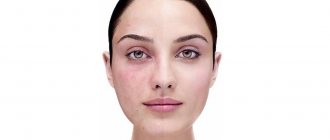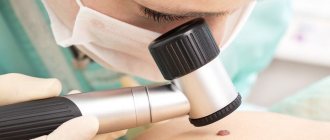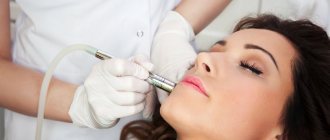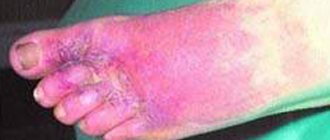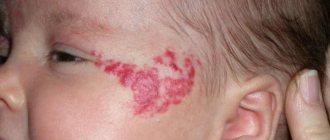Vitiligo - what is this disease, signs and causes of vitiligo
Vitiligo is a pigment abnormality. This disease promotes the destruction of colored skin cells - melanocytes, instead of which white spots appear on the affected area of the skin. The disease is characterized by the appearance of small depigmented spots that tend to increase in size and merge.
The number of such spots in some cases reaches several dozen. The hair on the affected skin can also become discolored. The disease can manifest itself at any age, regardless of the person’s gender. This disease is characterized by different localization and a rather long, usually progressive course. Often the process worsens after trips to sunny resorts.
Causes
An interesting fact is that this pathology is not congenital; white spots have to be treated after exposure to not only external, but also internal factors. Race is not particularly important, however, the disease is more often diagnosed in patients with dark skin.
The following reasons can provoke the development of the disease:
- Heredity.
- Endocrine and hormonal disorders.
- Exposure to chemicals that may be used in the production of low-quality cosmetics.
- Prolonged exposure to the sun.
- Use of certain pharmaceuticals.
- Pathologies of the digestive system.
- The presence of autoimmune processes in the body, in which antibodies tend to attack healthy cells instead of pathological ones.
- Various damage to the skin, burns - inflammatory reactions with an autoimmune component are triggered in the affected areas, most often it is the cells that produce pigment that react in this way.
The development of vitiligo can begin completely unnoticed by a person. Sometimes it is preceded by slight itching, increased sensitivity of the skin, a tingling sensation, “goosebumps”. Each spot that appears has a clear outline; more often, such spots with smooth or scalloped edges have a rounded shape. Apart from the white color, there are no changes in the skin, no peeling or atrophy.
With further development of the pathology, the spots begin to merge, increase in size, and can be observed on any part of the body. Lack of pigmentation is not the only sign of the disease; sometimes skin irritation is observed.
Why is vitiligo dangerous?
It is generally accepted that this disease does not pose a direct threat to human life or health. However, vitiligo itself is most often a consequence of some disorder in the body, which should not be ignored.
Therefore, if a person has vitiligo, you should pay attention to:
- Functioning of the thyroid gland.
- Taking medications, they may not be suitable and require immediate replacement.
- For the presence of other skin diseases, in particular psoriasis, baldness, etc.
- For malfunctions of the immune system and for factors that provoke these disorders. In addition, there is evidence of a connection between vitiligo and diabetes.
- Frequent stress or mental instability.
- Lack of nutrients in the body.
- Vitiligo is often observed with pneumonia and progressive myopia.
Therefore, if, in addition to vitiligo, a person is bothered by any other accompanying symptoms, this must be reported to the doctor. In addition, patients often require psychological help, since such a pronounced cosmetic defect can lead to psychological trauma, depression, the development of an inferiority complex regarding one’s own appearance, etc.
Classification
Vitiligo, depending on the location of the spots, is divided into three main types:
- localized form: spots are located in certain places;
- generalized form (the most common form): spots are located throughout the body;
- universal form (occurs least often): almost complete loss of pigment (more than 80% of the body area).
In turn, the main types are divided into subgroups. The generalized form includes acrofacial vitiligo (face and limbs only), vitiligo vulgaris (spots scattered symmetrically throughout the body), mixed vitiligo (a combination of different types). The localized form includes focal vitiligo (spots are present in 1–2 areas), segmental vitiligo (spots are located on one side of the body), mucosal vitiligo (spots are present only on the mucous membranes).
There is also a division according to the type of spots:
- blue spot - spots have a bluish tint;
- inflamed spot - the border of the spot is inflamed and raised;
- tricolor spot - between healthy skin and the spot there is a medium pigmented zone;
- four-color spot - in addition to three colors, a zone of strong pigmentation appears around the spot.
The course of the pathological process with vitiligo is divided into types:
- stable appearance: a white spot appears and remains unchanged for a long time;
- progressive type: there is a constant progress of the depigmentation process, sometimes it happens quickly, sometimes slowly;
- unstable appearance: some spots disappear, while other formations increase.
The use of various drugs to treat the disease in children and adults
As you know, any disease must be treated both externally and internally. That is why doctors prescribe a general course of strengthening internal therapy, as well as various ointments and masks that are applied to the affected areas of the skin. Remember that all medications have contraindications and side effects: they should not be used independently without consulting a specialist.
Medicines reduce the size of depigmentation
Table: medications used to treat skin with vitiligo
| Group of drugs | Examples of medications | Effects of use |
| Antibiotics |
| reduce the risk of secondary bacterial flora joining |
| Nonsteroidal anti-inflammatory drugs |
| reduce inflammation in the lesion |
| Glucocorticoid drugs | pills:
ointments:
| drugs in the form of tablets are used for the generalized form of vitiligo, in the form of ointments - for localized |
| Anti-dandruff products |
| reduce keratinization of the skin in the affected area |
| Antiseptics |
| minimize the risk of developing fungal and bacterial complications |
| Immunostimulants |
| stimulate the activity of the immune system |
| Means that help reduce depigmentation |
| normalize the condition of the skin |
| Vitamins and mineral complexes |
| reduce deficiency of vitamins and minerals in the body |
Drug therapy: photo gallery
Amoxiclav is a broad-spectrum antibiotic
Complivit - prescribed for the prevention and replenishment of deficiencies of minerals and vitamins
Nizoral is an antifungal drug
Boric acid is an antiseptic, disinfectant and antifungal agent
Vitasan cream improves skin color, eliminating the manifestations of vitiligo
Physiotherapy techniques used to treat illness
Physiotherapy is a branch of medicine that uses physical factors as the main tool to treat various diseases. Skin ailments also respond well to such therapy. Regular treatments are known to help reduce the size of spots and prevent their further spread. The course of treatment is drawn up by a medical rehabilitation doctor and can last from six months to several years.
After a course of physiotherapy, a pronounced decrease in the boundaries of the spots is observed
Table: physiotherapeutic methods for treating vitiligo
| Name of physiotherapy method | What is the essence of the procedure? | The main effects of physiotherapy |
| Laser therapy | a directed laser beam removes the stratum corneum of the epidermis | alignment of the boundaries between normal skin and the area of depigmentation |
| Hirudotherapy | the use of medicinal leeches on damaged parts of the body | leeches stimulate blood circulation and new cell growth |
| Phototherapy | exposure to bright sunlight with a specific wavelength |
|
| UV lamp | the use of ultraviolet irradiation of certain areas of the skin | |
| Puva therapy | the skin is irradiated under an ultraviolet light source along with a photographic preparation | |
| Liquid nitrogen cryotherapy | the chemical removes part of the epithelium, leaving space for new cells to regenerate | the area of depigmentation is destroyed, a crust forms in its place, which is then replaced by healthy, clean skin |
Homeopathic remedies
Homeopathy is considered a branch of alternative medicine that helps to cope with many diseases. It is also actively used in the field of dermatology. It is worth considering that such therapy, although it can bring serious results, is not always suitable for most people. The use of each remedy must be agreed with the attending physician.
For pathology use:
- Silica is a silicon-based drug that restores the deficiency of this element in the human body.
- Phosphoric acid - helps smooth out formations protruding above the surface of the skin.
- Sulfur ointment - reduces the size of spots.
- Mumiyo - prevents further spread of affected areas.
Diet therapy and therapeutic fasting as a way to cure vitiligo
Eating many foods can cause increased pigment loss and the growth of white spots. To prevent this from happening, patients must follow certain nutritional rules. With vitiligo, the body urgently needs a large amount of vitamins, minerals, as well as micro- and macroelements. When there is no deficiency of these substances, the formation of white spots may slow down.
What to add to your daily diet:
- vegetables and fruits;
- berries and greens;
- sea and river fish;
- seafood;
- fruit juices;
- lean meat;
- nuts;
- milk and dairy products (cheese, yogurt, cottage cheese, kefir, fermented baked milk);
- cereals and porridges (rice, buckwheat, rolled oats, millet, oatmeal, pearl barley);
- legumes (beans, chickpeas, lentils);
- durum pasta;
- yeast-free bread.
What you need to give up:
- chips and crackers;
- smoked products;
- fatty meat (pork, lamb, duck);
- chocolate, coffee and coffee drinks;
- fast food;
- instant food products;
- pastries with cream;
- butter;
- canned food
Many people use therapeutic fasting as a way to get rid of illness. It is believed that during hunger the body activates internal reserves that help it overcome the disease. Remember that this process must take place under the supervision of a doctor and last no more than seven days.
Useful and harmful foods for illness: photo gallery
Vegetables and fruits saturate the body with vitamins and minerals
Nuts contain vitamin E, healthy fats, and phytochemicals that perform a protective function for the skin.
The main dish for vitiligo sufferers should be porridge
Coffee and chocolate should be excluded from the diet
Traditional medicine recipes that help get rid of stains
Traditional medicine is used as an adjuvant to combat vitiligo. The methods used quite effectively even out skin tone and prevent further spread of spots. Folk remedies have distinct advantages: they are cheap, easy to prepare or purchased at any pharmacy. It is worth considering that patients with allergic reactions cannot use most prescriptions.
- Cabbage brine for skin is a universal and easy-to-prepare remedy. Take one head of cabbage and finely chop it into a three-liter jar. Fill it up to the neck with water and add three tablespoons of salt. The brine should be infused in a dark place for at least a week, after which you can wipe the skin in the area of the stains: this will help return them to their normal color.
- St. John's wort oil is sold in any pharmacy. This drug helps relieve inflammation and reduce the discomfort that occurs when an infection develops in the vitiligo area. Apply a small amount of oil to a cotton pad and wipe the affected areas.
- The bite helps even out skin tone. Take 250 milliliters of vinegar and crushed sesame seeds in an amount of 50 grams. Mix them until you get a paste-like content, which must be applied to the stains.
- A compress of birch tar and clover helps stimulate blood circulation in all layers of the epidermis. Mix the crushed components, taken in equal proportions, until the consistency of a homogeneous ointment is achieved. Apply it to gauze, wrap a bandage on top and leave for two hours.
- A mixture of eucalyptus oil, honey and aloe helps even out skin tone: spots will begin to noticeably darken and will no longer stand out brightly. Mix the components in equal quantities. Add some boiled water. Apply the resulting mixture to vitiligo twice a day for an hour.
- Massage with a product based on horseradish, onion and garlic will help stimulate cell regeneration. Take one piece of each ingredient and grate on a coarse grater. Add a few drops of lemon juice and apply the resulting mixture onto a cotton pad. Make rubbing movements for five minutes.
- The procedure using mumiyo is aimed at stimulating the synthesis of collagen by skin cells, which leads to an improvement in its regenerative properties. Combine mumiyo with black cumin oil, then soak a cotton pad in this liquid and wipe the stains.
- Turmeric, parsnip root, duckweed are ideal herbs that relieve tissue swelling during inflammation of vitiligo areas. You need to brew them and take baths for forty minutes.
- Seed and milk thistle help reduce the size of the affected area. Brew 20 grams of each herb and wipe your limbs, body and face with this liquid twice a day.
Traditional recipes help to slightly remove stains
Treatment of vitiligo with stem cells
Stem cells are a completely new word in the treatment of skin pathologies. It has long been known that the body of each person contains three types of cellular structures: immature, otherwise called stem, mature, and dying. The peculiarity of immature cells is their ability to transform into any element of the human body: they can form completely healthy tissue and even an organ. Currently, there are not many successful transplants of these cellular structures, but new research promises truly stunning results.
The affected area returns to normal color after stem cell therapy
In 70% of patients, partial repigmentation of the skin was observed, while about 20% received a significant reduction in the halo of spots over the entire surface of the skin.
This procedure is very complex and expensive, so it is carried out mainly in foreign clinics. Once the research is completed, stem cell therapy will be available worldwide.
Cosmetic procedures to help fight the disease
As you know, cosmetology helps not only restore tissue elasticity and cure acne, but also helps even out skin tone. For vitiligo, a visit to a cosmetologist is carried out in the first few days after diagnosis. In addition to carrying out basic procedures, the doctor helps you choose specific care and protect your skin from the sun.
What methods can cosmetology offer to reduce vitiligo spots:
- ultrasonic cleaning, which reduces the spread of stains on the skin;
- chemical peels that remove the top layer of the epidermis;
- masks based on various herbs and oils;
- facial massages;
- biorevitalization - introduction of hyaluronic acid into tissues;
- mesotherapy - the introduction of vitamins and minerals into the skin.
A few months after cosmetic procedures, you can notice a pronounced result.
Video: treatment of vitiligo in children and adults
What are the symptoms of the disease?
The main manifestation of the disease is white spots on the body. Foci of the disease can occur at any age, often in childhood and adolescence, and can form on all areas of the skin. The places where the skin is most traumatized are at greatest risk for the appearance of depigmented areas - spots appear on the legs, knees, hands, and elbows.
- In areas of vitiligo, sweating is impaired, and the skin becomes unable to respond normally to cold and heat. The hair on the whitened areas of the body in many patients also becomes discolored. Individual spots can disappear spontaneously even without treatment, but as the disease progresses, foci of depigmentation can form at the sites of recent injuries, friction or pressure on the skin.
- The initial stage of vitiligo is very mild. It is characterized by minor foci of depigmentation - small spots that look like a noticeable, but not particularly noticeable cosmetic defect that is easy to disguise with clothing. Gradually, the light spots on the skin enlarge and unite, forming large areas of milky white color.
Vitiligo disease does not cause any disturbing symptoms; it is not contagious, but it is difficult to cure. Vitiligo is perceived by patients as a serious aesthetic defect, so the disease can cause severe psychological discomfort. After tanning, discolored areas become very noticeable; the affected areas of the skin are very sensitive to ultraviolet radiation and quickly “burn.”
“Mom has white bangs, and so do I.”
Alina, 28 years old - I have had vitiligo since birth.
Until I was six years old, I was taken to doctors, we tried all the folk remedies and even went to my grandmother to remove the damage. As a result, my family reconciled, realizing that it was all useless, and stopped tormenting me. I can say that I was lucky: my hands and face were not affected by vitiligo, but there are light strands on my head - such a white bang. On the arms, spots extend from the wrist to the elbow, and they are also present on the stomach and legs. At school, the teachers were indignant about why my mother dyed my bangs blonde, but she explained everything to them, and it ended. I don’t remember any reaction from my classmates.
Of course, in adolescence there was a rejection of appearance, there were complexes. I tried to wear clothes that were as closed as possible so that the stains would not be visible, and I used self-tanner. Vitiligo also affects your lifestyle - it’s better not to sunbathe, because you can instantly get burned. As a child, I was always burned.
There were no problems in my personal life or with friends. The only thing that bothered me was strangers who could look at me on the street. But the older you get, the less you care what others think. Previously, I hid the spots when strangers looked, but now, when they look at me, I look straight in the eyes - interest in me instantly disappears.
Now I have another problem: I worry about my daughter, how she will cope with the same situations that I had. She was also born with white bangs. While she is four years old, she doesn’t ask any questions, she just says: “Mom has white bangs, and so do I.” The husband reacts calmly to all this: he says that he got two such beauties.
Diagnostics
Vitiligo spots at first glance can be confused with spots that occur with lichen or syphilis. However, the latter two diseases are characterized by symptoms other than skin discoloration. Thus, with syphilis, specific lesions of the mucous membrane are observed, and with lichen, the surface of the spots peels off.
The most accurate way to determine vitiligo is by shining a Wood's lamp on the spots. Under it, the affected areas will be highlighted blue-white, and areas where the pigment has just begun to disappear will also become visible. When visiting a dermatologist, it is better to insist on this diagnostic method.
Treatment prognosis and possible complications of the disease
Unfortunately, vitiligo is an incurable disease. This means that even if all medical recommendations are followed, there is a possibility of growth and development of white spots on the skin. Disability due to disease is issued only in cases of bacterial flora, if the spots become inflamed and begin to itch at least three times within one month. In other cases, a certificate of incapacity for work is not provided.
The main complications of the disease include:
- psychological stress and depression;
- dysmorphophobia syndrome - non-acceptance of one's appearance;
- inflammation of affected skin areas;
- development of burns and frostbite on depigmented tissue areas;
- inflammatory diseases of the mucous membrane of the eye;
- tendency to develop allergic reactions.
As you know, there is a hypothesis that vitiligo can develop into a cancerous tumor. This never actually happens.
Areas of the skin that lack pigment are more sensitive to ultraviolet rays, so patients are not recommended to stay in the sun for a long time: it can provoke the development of melanoma, a malignant neoplasm.
How to treat vitiligo?
If the affected area of vitiligo is no more than 20% of the body, topical glucocorticosteroids in the form of creams and ointments are first prescribed for treatment.
- methylprednisolone aceponate (advantan and analogues);
- alklometesone dipropionate (afloderm and analogues);
- betamethasone dipropionate (actiderm and analogues).
There are several schemes for using these drugs; the doctor chooses the optimal scheme based on test results, area of damage, patient’s age and other factors. If no visible effect is observed within 4-6 months, second-line drugs are prescribed - topical calcineurin inhibitors:
- tacrolimus, ointment of varying degrees of concentration;
- pimecrolimus cream.
It is worth considering that despite successful studies (2013), the diagnosis of vitiligo is still not officially included in the indications for use.
Recommendations for prevention and lifestyle changes
Vitiligo is a disease that leaves some imprint on a person’s existence. Many people are embarrassed by their defects, while others play up this feature of their skin to their advantage. With vitiligo of the genital organs, it is not prohibited to have sex, visit the bathhouse and sauna, or swim in the pool. The disease itself does not cause any dangerous changes in the human body. However, it is worth remembering a few simple rules of prevention that will help avoid unwanted consequences:
- do not stay in the sun for too long, always use protective cream and cover depigmented spots with a cloth;
- stop visiting solariums once and for all;
- do not apply tattoos (both temporary and permanent) to the affected areas of the skin;
- eat right;
- engage in sports activities (yoga, wrestling, dancing);
- visit a dermatologist and cosmetologist once every six months to undergo all necessary tests;
- use cosmetics (foundation, bronzer, primer, powder) to hide skin defects.
Cosmetics mask skin imperfections well
How can you get rid of vitiligo?
New methods in the treatment of this disease:
- Skin whitening. This is an attempt to equalize the tone of the affected areas and healthy skin. Today, the most popular means for this procedure are injections of eloquin, hydroquinone (2-4%) and its monobenzyl ether (Monobenzone) externally. All drugs are quite aggressive and have a lot of side effects, so they cannot be considered a panacea in solving the problem of depigmentation. In addition, the price tags on them are quite steep (an injection of Eloquin costs about 50 thousand rubles), and lightening occurs in patches, so almost constant use of the drug is required.
- Laser therapy. This is the elimination of areas of depigmentation with narrowly targeted radiation with a wavelength of 308 nm. In this case, the mechanism of action is almost similar to phototherapy. In this case, the greatest effectiveness is achieved in individuals with local forms of the disease and the duration of the pathological process of no more than five years. The duration of radiation in one session is seconds. Other names for this method are excimer laser or Ratokderm. Read more about contraindications and indications for laser therapy.
- Melagenin plus. This is an alcoholic extract of human placenta produced in Cuba. Under the name Melagenin, the drug has been on the market since 1998 and is characterized by average effectiveness against localized forms of the disease.
- Melanocyte transplantation. This is the introduction of pigment cells taken from healthy areas of the patient’s skin into his problem skin.
- Creation of a vaccine. In 2013, scientists from the University of Chicago Medical School tested a protein vaccine that suppresses the autoimmune reaction that leads to vitiligo in a series of experiments on mice. However, until now there has been no information about the completion of work on the vaccine.
The Australian drug Sceness, registered in Europe for the treatment of erythropoietic protoporphyria, also holds promise for the treatment of depigmentation in vitiligo.
Some drugs used for vitiligo
Melagenin
Melangenin is used as a topical treatment for vitiligo. It is able to restore skin pigmentation by enhancing its ability to absorb ultraviolet rays.
Currently, the drug Melagenin Plus is actively used, which acts in the same way as melagenin, but its effect is enhanced by the calcium chloride and alcohol extract of human placenta included in the composition. This allows cells to multiply more actively and synthesize melanin with higher bioavailability.
The product is used even in the most severe cases of vitiligo. At the same time, reviews indicate that the depigmentation process does not return, and normal skin is not damaged.
The drug should not be used while pregnant or breastfeeding. It can be used independently, without additional exposure to an infrared lamp.
Ammifurin
The drug Ammifurin is a photosensitizing drug that is prescribed to patients with vitiligo when exposed to ultraviolet rays. Available in the form of tablets and solution for external use, it stimulates the production of melanin.
If used in the form of a solution, the product should be applied before the start of irradiation, one hour before the procedure. If oral use is indicated, then you should take the tablets after meals and drink milk, but 2 hours before ultraviolet irradiation.
The drug is prohibited for use during pregnancy and breastfeeding, in the presence of hypersensitivity to the active substance, stomach ulcers, pancreatitis, cirrhosis, hepatitis, diabetes, cachexia, nephritis, tuberculosis, cataracts, nevi, tumors, high blood pressure and thyrotoxicosis.
It is important to use glasses with dark lenses to protect your eyes while taking the drug in sunny hours. As for effectiveness, the best results in the treatment of vitiligo were recorded in young people, with a short duration of the disease, as well as in brunettes and patients prone to tanning.
The product should not be used independently, without strict medical supervision.
Vitasan
Vitasan is available in the form of a cream and consists exclusively of natural ingredients. It is able to have a complex effect: regulates immune processes, has a sensitizing effect, and stimulates the production of melanocytes.
The product contains the following components:
- St. John's wort extract, which enhances the sensitization effect and increases the sensitivity of the skin to ultraviolet radiation;
- Walnut extract, which saturates the skin with vitamins and microelements necessary for vitiligo - copper, zinc, ascorbic acid, etc.;
- Sequence extract, which enhances the reaction of formation of the pigment necessary for vitiligo;
- Calendula extract containing vitamins PP, C and B;
- Fir oil, which is capable of dilating blood vessels, stimulating blood supply, cell division and growth, and the development of local immunity;
- Cedar nut oil, which contains vitamin E.
For those suffering from vitiligo, it is necessary to apply the product twice, rubbing in thoroughly. To achieve maximum effect, you should use the cream in advance, before the onset of periods of maximum solar activity, that is, in winter.
Among the contraindications, one can highlight only individual intolerance to the components that make up the cream. If side effects occur in the form of itching, redness and burning, you should wash off the product and consult a doctor.
It is important to use the cream not as a single treatment, but as part of complex therapy.
Phototherapy
Phototherapy - treatment with light of a certain wavelength - for vitiligo is used in the form of selective phototherapy, PUVA therapy, narrow-wave UVB phototherapy at a wavelength of 311 nm. Selective phototherapy is the least effective, PUVA therapy (taking photosensitizers psoralens orally followed by irradiation of the skin with UVA rays) is much more effective in comparison with selective phototherapy, however, toxic effects manifested by nausea, vomiting, headache, dizziness, as well as the risk of developing skin cancer with long-term use limits the use of PUVA therapy in the treatment of vitiligo.
Narrow-wave 311 nm UVB phototherapy is comparable in effectiveness to PUVA therapy (restoration of pigmentation in more than 75% of the area of vitiligo lesions in 70% of patients), however, it is devoid of toxic side effects and, moreover, is approved for use in the treatment of children. The most noticeable therapeutic effect is observed in the presence of lesions in the face, neck, torso and proximal limbs. When localized on the fingers and toes, the effect is less pronounced. In addition, lesions that appeared no more than 2-5 years ago respond better to treatment.
Phototherapy, namely narrow-wave 311 nm UVB phototherapy, is currently considered one of the most accessible and effective methods of treating vitiligo. The method is quite safe, and this is important for long-term use. To achieve a good effect, 30 to 100 procedures are required, 2-3 times a week.
Why you need to contact the Mama Papa Ya clinic
Our clinic offers quality services at affordable prices:
- consultation with a qualified dermatologist familiar with modern methods of treating the disease;
- the opportunity to attend physical therapy;
- the use of non-traditional methods of treatment, such as acupuncture;
- the ability to treat family members of different ages;
- careful observation of a specialist for the effectiveness of treatment, if necessary, the use of additional methods.
Call our clinic by phone or make an appointment at a time convenient for you through the form on our website.
Reviews
Good clinic, good doctor!
Raisa Vasilievna can clearly and clearly explain what the problem is. If something is wrong, she speaks about everything directly, not in a veiled way, as other doctors sometimes do. I don’t regret that I ended up with her. Anna
I would like to express my gratitude to the staff of the clinic: Mom, Dad, and me. The clinic has a very friendly atmosphere, a very friendly and cheerful team and highly qualified specialists. Thank you very much! I wish your clinic prosperity.
Anonymous user
Today I had a mole removed on my face from dermatologist I.A. Kodareva. The doctor is very neat! Correct! Thanks a lot! Administrator Yulia Borshchevskaya is friendly and accurately fulfills her duties.
Belova E.M.
Today I was treated at the clinic, I was satisfied with the staff, as well as the gynecologist. Everyone treats patients with respect and attention. Many thanks to them and continued prosperity.
Anonymous user
The Mama Papa Ya clinic in Lyubertsy is very good. The team is friendly and responsive. I recommend this clinic to all my friends. Thanks to all doctors and administrators. I wish the clinic prosperity and many adequate clients.
Iratyev V.V.
We visited the “Mama Papa Ya” Clinic with our child. A consultation with a pediatric cardiologist was needed. I liked the clinic. Good service, doctors. There was no queue, everything was the same price.
Evgeniya
I liked the first visit. They examined me carefully, prescribed additional examinations, and gave me good recommendations. I will continue treatment further; I liked the conditions at the clinic.
Christina
The doctor carefully examined my husband, prescribed an ECG and made a preliminary diagnosis. She gave recommendations on our situation and ordered additional examination. No comments so far. Financial agreements have been met.
Marina Petrovna
I really liked the clinic. Helpful staff. I had an appointment with gynecologist E.A. Mikhailova. I was satisfied, there are more such doctors. Thank you!!!
Olga
Surgical intervention
In 20% of cases, conservative treatment of vitiligo does not give the desired result, then surgery is considered. Surgical treatment consists of transplanting one's own healthy melanocytes onto lesions devoid of pigment. After surgery, new melanocytes are formed in the deep layers of the epidermis. The process of restoring pigmentation takes several months.
Indications for surgical treatment of vitiligo
- The lesions are located on open areas of the body (face, neck, décolleté, arms). They are a significant cosmetic defect and violate the psychological status of the patient.
- Lack of results from local and systemic therapy for 12 months.
- The disease is in remission. Over the course of 1-2 years, new spots do not appear, and existing ones do not grow.
There are several methods of surgical treatment of vitiligo.
- Epidermal transplantation. The affected areas of skin are excised. In their place, an autograft prepared by the PUVA method is placed (a flap of epidermis from a healthy area of the body).
- Minitransplants. Areas of healthy skin less than 1 mm in size are transplanted into depigmented lesions.
- Transplantation of cultured or uncultured melanocytes. Individual cells that produce pigment are implanted into the skin.
Side effects of surgical treatment may include:
- The appearance of scars;
- Uneven pigmentation;
- Rejection of transplanted areas of the epidermis;
Contraindications:
- Tendency to the appearance of scars;
- Intolerance to ultraviolet radiation and laser therapy.
Clinical and symptomatic characteristics of the disease
Vitiligo is a common pathology that may not cause its owner any significant discomfort. The most common symptom is the appearance of white spots on the surface of the skin, which are strikingly different from the main color of the body or face. Most often, they are not accompanied by skin itching, do not have seals on the surface and do not stand out in any way on the topography of the integument. These areas are more sensitive to temperature changes, and also tolerate sunlight less well and burn faster. Hair, moles or other formations almost never grow on them.
Vitiligo has clear boundaries
There are the following types of stains:
- with blue and bluish coloring;
- tricolor spots characterizing the transition from normal skin to a white area;
- inflamed reddened depigmented spots.
Other symptoms that may occur with this pathology include:
- hair loss in the nape of the neck in men and women;
- inflammatory eye diseases (conjunctivitis, keratitis, retinitis);
- dermatitis and dermatoses;
- lightening of hair follicles on the vitiligo-prone part of the head.
How to cover up vitiligo spots?
The desire to hide white spots on the face and body is a completely natural desire of people suffering from vitiligo. Therefore, while treatment is being carried out, you can use the following methods:
- A method such as dermabrasion can help disguise vitiligo. In this case, the skin is treated layer by layer, and the depth of penetration depends on the form of the disease, the age of the spots, etc.
- Using self-tanner. If you perform this procedure in a salon, the color will be more even and will last longer. In addition, it can be problematic to choose a shade and apply it to the body on your own. Unlike cosmetics, self-tanning is convenient to use on your arms and legs, as it does not stain your clothes.
- Using green walnut peel. To do this, you need to grind it using a blender and leave for 2 hours. After this, the mixture should turn brown. The juice from the peel should be squeezed out and applied to the stains using a cotton pad, which will help color them. One of the advantages of this product is that it does not leave marks on clothes.
- Use of cosmetics. This is the most affordable and easiest way to make stains less noticeable. At the same time, you need to apply foundation and other mattifying products correctly. First, the skin must be evened out to its natural color, and only then begin to mattify. In addition, you can use permanent tattooing, which will be more durable and will not be erased upon contact with clothing or water.
However, when using these products, it is important not to forget about the rules of caring for affected skin. You should not injure it again or expose it to allergens. It is important not to wear clothes and shoes that are too tight, and not to allow stains to rub; if there is a need to use a razor, then you should be as careful as possible. Jewelry should not leave visible marks on the neck or fingers. It is necessary to limit time spent both in the sun and in the cold. After all, tanning most often provokes the formation of new spots.
“Of course, we’ll have to learn to live with it all over again.”
Daria, 31 years old
“I developed vitiligo 14 years ago. I was 17, I was entering my first year of college. It was not clear why it started - spots simply appeared on the thighs and began to grow. Now I even have vitiligo on my face, around my eyes.
The doctor told me that there is very little information about this disease. I bought some ointment at the pharmacy and tried to be treated with folk remedies, but then I stopped using anything - nothing helped.
Of course, complexes appeared. I cried, was very worried, and used foundation to cover it all up. Some ill-mannered classmates asked me: “Are you sunbathing with glasses on? What are your spots? Of course, I was embarrassed, I wanted to turn away, hide... It’s just this kind of situation: you live for 17 years with the same appearance, and then one day it changes not at all according to your wishes. Of course, you will have to learn to live with this again.
My boyfriend helped me accept myself. When I started communicating with him, he gave me the opportunity to believe that I was special, that there was nothing special about my spots. I posted my first photo with vitiligo on Instagram in 2022, when someone wrote to me in direct message: “What’s wrong with your face?” And I decided to post a photo without filters, without anything, and write that I have vitiligo and that it is not contagious. Many acquaintances, having seen the photo, wrote to me that they did not even notice my spots and did not pay attention to them. In general, everyone reacted adequately.
Now many people come to me with the same problem as me, especially those who have it recently: “You are such a cheerful girl, how do you cope? I’m depressed because of this...” I’m pleased that I’m sharing my experience: maybe it will help someone. And if they write to me something about some new treatment for vitiligo, I immediately close the dialogue. I have already accepted this fact and I don’t want to give myself unnecessary hope. Only time will help you accept yourself. “Reconcile” is not the right word here, just accept. It took me five years.
Last news
Scientists have created a genetically modified protein that treats vitiligo in mice. Previous studies have shown that HSP70i, a stress-inducible heat shock protein (its synthesis is activated when the temperature rises), plays a key role in the disease vitiligo.
- HSP70i consists of 641 amino acids. Researchers at Loyola University New Orleans replaced one of these amino acids, creating a genetically modified version of HSP70i. The new modified protein displaces its normal predecessor and stops the development of the autoimmune reaction.
- Scientists injected the modified HSP70i into experimental mice suffering from vitiligo and having a salt-and-pepper coloration. After some time, the mice's fur returned to its normal black color. Similar effects were obtained in experiments on human skin cell cultures.
Experimenters hope that human studies will confirm the effectiveness of the new method and finally make it possible to find a cure for vitiligo. True, the experiments were carried out back in 2013, and nothing more was heard about them. Perhaps the experiments stopped due to the unsafety of genetically modified developments.
Repigmentation stage
This form is observed quite rarely in patients. Most often, it is discovered when the appearance of spots is the result of medications or other medical procedures.
If treatment is started at an early stage of vitiligo, it is possible to achieve normal melanin production in the skin. This is most often observed in children under 4 years of age: when melanocyte function is restored, skin repigmentation occurs.
If, nevertheless, it is impossible to resume normal pigment production in the affected areas, then therapeutic measures are taken to prevent further progression of the pathology, the goal is to stop the growth of depigmented areas.
Prevention
Since the cause of vitiligo has not been established, the prevention of this disease is not sufficiently justified. However, it has been noted that regular stays at seaside resorts have a beneficial effect on patients with vitiligo, therefore, if there are cases of vitiligo in the family, you should organize an annual (and if possible, more often) family vacation to the sea. To consolidate the preventive effect, you can take sunbathing for 10 minutes a day throughout the warm period of the year.
You should avoid overloading the body with substances from impaired metabolism: treat chronic diseases of the digestive system, eat a balanced diet.
What vitamins should I take for vitiligo?
Conducted scientific studies prove that taking certain vitamins (for example, E, C, alpha-lipoic acid) affects the course of the disease and can enhance the therapeutic effect. Therefore, doctors often prescribe certain medications to patients with this skin disease. Among the most popular are thiamine, ascorbic acid, pantothenic acid and riboflavin.
The role of folic acid
In Sweden, studies were conducted on the effect of folic acid and vitamin B12 on vitiligo. The study involved 100 patients with vitiligo, all of whom took 5 mg of folic acid twice a day and 1 mg of vitamin B12 once a day. A prerequisite was daily exposure of the skin to ultraviolet rays. Exactly 3 months later the results were summed up. More than half of all participants achieved positive results, and several patients were completely cured by 100%.
On this topic:
10 most effective folk remedies in the treatment of vitiligo

